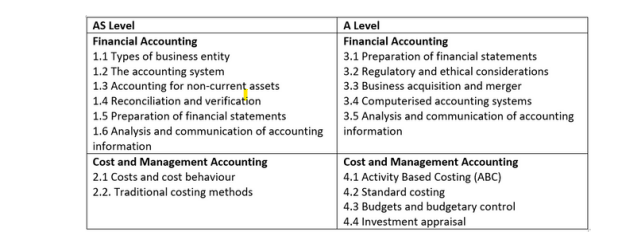Syllabus changes in Cambridge International AS & A Level Business (9609)
There are a number of new areas of study and a considerable amount of material has been switched between AS and A Level. One particularly significant change is that strategy is part of each of the functional areas at A Level and not just a stand-alone section.
Some Changes includes:
1.1.2 Intrapreneurs has been introduced as a topic alongside entrepreneurs
1.3.3 Business growth contains some new material and has been moved to the AS syllabus
3.1.7 Customer relationship marketing has been added
2.1.1 The purpose and roles of human resource management (HRM) has been introduced
5.4 All material on costs is in the AS syllabus and some new material on break-even analysis
6.2 Scenario planning and blue ocean strategy have been added
7.3 A number of new theories of leadership have been introduced and all material on this topic has been
moved to A Level
Topics in the current syllabus which will be no longer covered include:
The marketing mix: the role of the customer (the 4Cs) and using the internet for the 4Ps/4Cs
Sources of finance: short and long-term finance
Cash flow: the construction of cash flow forecasts
Investment appraisal: the internal rate of return (IRR)
Strategic management: Chandler’s assertion and strategy and competitive advantage
Syllabus changes in Cambridge International AS & A Level Economics (9708)
The revised syllabus is now organised into the following six main sections:
1. Basic economic ideas and resource allocation
2. The price system and the micro economy
3. Government microeconomic intervention
4. The macro economy
5. Government macroeconomic intervention
6. International economic issues
Teachers are advised to build learners’ knowledge around the updated seven (rather than the old five) key concepts:
1. Scarcity and choice
2. The margin and decision-making
3. Equilibrium and disequilibrium
4. Time
5. Efficiency and inefficiency
6. Regulation, equality and equity
7. Progress and development
As you would expect, our new edition of Cambridge International AS & A Level Economics has been updated to reflect the changes in the syllabus coverage and structure.
New areas of study include the following:
1.2.1 Economics as a social science
1.3.2 Difference between human capital and physical capital
1.5.4 Significance of a position within a PPC
2.4.3 Relationships between different markets: derived demand
2.4.4 Functions of price in resource allocation: incentivization
2.5.4 Significance of price elasticity of demand and of supply in determining the extent of the changes in consumer and producer surplus
3.1 Reasons for government interventions in markets
3.2.5 Buffer stock schemes
3.2.6 Provision of information
5.1 Government macroeconomic policy objectives
5.2.5 Government spending: types of spending: capital (investment) and current
7.8.4 Other pricing policies: predatory pricing
8.1.1 Application and effectiveness of measures to tackle different forms of market failure: production quota
8.2.5 Policies towards equity and equality, for example: universal basic income
9.2.5 Inclusive economic growth
9.3.3 Voluntary and involuntary unemployment
9.3.6 Mobility of labour
11.6.1 Meaning of globalization and its causes and consequences
Changes to the AS/A Level allocation of topics to balance the content between the two levels include the following:
Topics moved from A Level to AS Level:
3.3 Addressing income and wealth inequality
4.1 National income statistics
4.2 Introduction to the circular flow of income
4.4 Economic growth
4.5 Unemployment
Topics moved from AS Level to A Level:
8.1.1 Application and effectiveness of measures to tackle different forms of market failure: specific and ‘ad valorem’ indirect taxes; nationalization and privatization
9.4.1 Definition, functions and characteristics of money
11.2.1 Measurement of exchange rates: distinction between nominal and real exchange rates · trade-weighted exchange rates
11.2.2 Determination of exchange rates under fixed and managed systems
11.2.3 Distinction between revaluation and devaluation of a fixed exchange rate
11.2.5 The effects of changing exchange rates on the external economy using Marshall-Lerner and J curve analysis
11.6.2 Distinction between a free trade area, a customs union, a monetary union and full economic union
11.6.3 Trade creation and trade diversion
Topics in the current syllabus which will no longer be covered include:
- The Canons of Taxation
- Aggregate Expenditure (AE) function
- Keynesian and Monetarist schools
- The impact of corruption, and importance of the legal framework in an economy
The assessment objectives have been revised into three categories and their weighting in the overall assessment grid has been updated:
AO1: Knowledge and understanding (application is now tested within this objective)
AO2: Analysis
AO3: Evaluation
The weighting of the assessment components in the AS and the overall A Level has been amended to reflect the changes in structure and total marks
Paper 2 now carries 60 marks and its duration is 2 hours
Paper 4 now carries 40 marks and its duration is 2 hours
Syllabus changes in Cambridge International AS & A Level Accounting (9706)
The revised syllabus is now organised into the following four main sections:

As you would expect, our new edition of Cambridge International AS & A Level Accounting will be updated to reflect the changes in syllabus coverage and structure. New areas of study include the following:
1.1.1 Types of business entity
1.6.2 Measures to improve the profitability, liquidity and efficiency of an organisation
2.1 The principles of just in time (JIT) management of inventory
2.2.3 Make-or-buy, special orders, closure of business unit and target profit
3.1.3 Clubs and societies (currently on the existing syllabus as ‘not-for-profit’ organisations)
3.1.2 How to evaluate business decisions based on possible changes in the composition of a partnership
3.2.2 Ethical considerations
3.5.1 Interest cover ratio
Topics in the current syllabus which will no longer be covered include:
Folio references
Authorized share capital (as a contrast to issued share capital)
Income gearing ratio
Consignment and joint venture accounts
Sensitivity analysis
Calculation of labor costs using different methods of remuneration including bonus schemes
LIFO as a method of inventory valuation
Preparation of break-even charts
In addition to changes in the topics covered throughout the syllabus, there have also been some adjustments to the delivery of topics between AS & A Level.
Moved from AS Level to A Level:
1.4.3 Partnerships
Prepare capital and current accounts to record changes required in respect of goodwill and revaluation of assets on the
introduction of a new partner, retirement of an existing partner and the dissolution of a partnership.
⤷ Now moved to 3.1.2
2.3 The application of accounting to business planning
The benefit to business planning by the use of accounting data.
Candidates should be able to:
• Explain the need for a business to plan for the future
• Explain why organisations prepare budgets and the benefits they bring to the planning process
• Explain the advantages and disadvantages of budgetary control, including both financial and non-financial factors
⤷ Budgeting is now contained within 4.3
Moved from A Level to AS Level:
1.4 Computerised accounting systems
The need for and the ability to discuss the process of computerising the accounts of a business.
Candidates should be able to:
• Discuss the advantages and disadvantages of introducing a computerised accounting system
• Discuss the process of computerising the business accounts
⤷ Now moved to 1.2.1
In terms of the assessment, there are four externally assessed exam papers.
Paper 1 and Paper 2 assess the AS Level content. Papers 1, 2, 3 and 4 assess the A Level (i.e. the total) content
Paper 1 ‘Multiple choice’ is a 1 hour paper consisting of 30 multiple choice questions based on sections 1 and 2 of the
syllabus content. It counts for 28% of the AS level (or 14% of the A Level)
Paper 2 ‘Fundamentals of accounting’ is a 1 hour 45 minute paper consisting of 4 structured questions based on
sections 1 and 2 of the syllabus. It counts for 72% of the AS level (or 36% of the A Level)
Paper 3 ‘Financial accounting’ is a 1 hour 30 minute paper consisting of 3 structured questions based on section 3 of the syllabus content. It counts for 30% of the A Level
Paper 4 ‘Cost and management accounting’ is a 1 hour paper consisting of 2 structured questions –
based on section 4 of the syllabus. It counts for 20% of the A Level
⤷ For Papers 3 and 4, knowledge of the AS Level content is assumed


